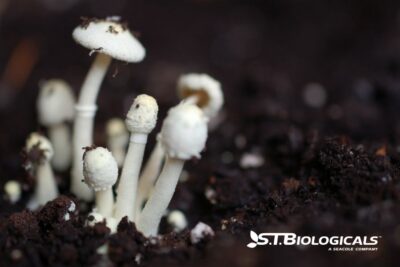Soil microorganisms break down organic matter to provide plants with a steady flow of essential nutrients. By supporting microbial life and soil builders like earthworms, you can create a thriving, self-sustaining ecosystem that enhances soil structure, nutrient cycling, and plant resilience at your operation.
Microorganisms do much more than simply enrich the soil. They act as gradual dispensers of nutrients, which is essential for the growth and health of plants.
Organic matter, when broken down by the teeming life within the soil, releases nutrients at a pace that aligns with plant needs. At the same time, organic matter stimulates the bustling microbial life in the rhizosphere, the region surrounding plant roots, which is vital for robust growth. This reciprocal relationship between soil health and plant vigor is at the heart of a flourishing ecosystem, anchoring the harmony between microorganisms and plant roots in the continuous cycle of life.
Microorganisms Facilitate the Slow Release of Essential Nutrients
Through the intricate dance of decomposition and nutrient release, organic matter acts as a slow-release fertilizer. Beneficial fungi and bacteria gradually break down organic compounds. This yields a steady stream of food for plants.
This measured release mirrors the natural rhythm of plant growth, ensuring a consistent supply of nitrogen, phosphorus, and potassium along with a suite of micro-nutrients vital for plant development. This process eliminates the shocks to the system that can occur with synthetic fertilizers, promoting an even, sustainable growth pattern in crops without the risk of nutrient burn or rapid leaching.
Boost Beneficial Microbial Activity in the Rhizosphere
Organic matter serves as a dynamic stage where essential soil bacteria and fungi flourish. By secreting enzymes and organic acids, these microorganisms break down complex organics, liberating nutrients near plant roots and fostering the rich tapestry that is the rhizosphere.
This microbial heaven directly impacts plant health, driving efficient nutrient absorption and bolstering plants’ resistance against pathogens. Such a boost in microorganism populations and nutrient cycling efficiency underscores the symbiotic relationships between soil and plant life and ecosystem resilience.
Attracting Earthworms and Other Soil Builders
Crop residues and other plant debris draw earthworms and numerous soil architects to your soil, setting the stage for an enriched subterranean ecosystem. Organic materials act like a beacon, inviting these industrious workers to aerate the soil and foster a natural soil structure that is crucial for plant growth. Earthworm activity generates a more robust soil food web that feeds plant roots.
Sustainable ag practices invite these soil builders, along with their microbial counterparts, to converge, turning the soil into a crucible of life that supports robust crop yields and ecosystem resilience. Enriching the soil with organic inputs, you can foster an environment ripe for the proliferation of earthworms and other beneficial organisms. Their activity within the soil is a testament to the health of your land and indicative of a dynamic, living system brimming with potential.
Do you want to learn more about soil microbes and nutrient cycling? Contact the mentors at ST Biologicals today. We’re here to help you succeed. When soil speaks, we listen.
Soil Microorganisms FAQs
How do soil microorganisms help plants get nutrients?
Microbes break down organic matter in the soil, releasing nutrients gradually in sync with plant growth for steady, healthy development.
What is the rhizosphere, and why is it important?
The rhizosphere is the zone around plant roots where beneficial microbes live. It’s a hotspot of nutrient exchange that supports strong, disease-resistant plants.
How do earthworms and other soil organisms improve soil health?
Earthworms aerate the soil, enhance structure, and create pathways for water and roots, while their castings enrich the soil with readily available nutrients.
Why should farmers focus on building microbial life instead of relying solely on synthetic fertilizers?
A healthy microbial community releases nutrients naturally and sustainably, reducing the need for synthetics and preventing nutrient loss through leaching or burn.

